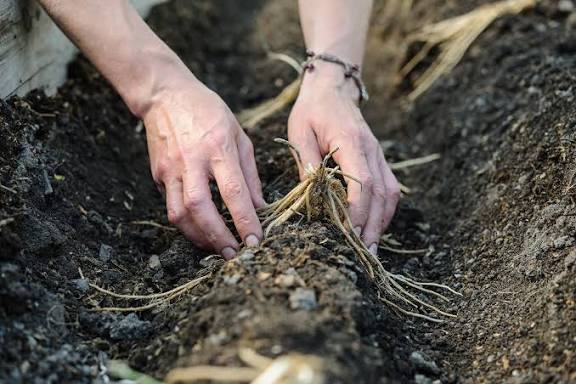If you’ve ever dreamed of harvesting your own tender, homegrown asparagus, you’re in the right place! This hardy perennial vegetable rewards patience with years—sometimes decades—of delicious harvests. Whether you’re new to gardening or expanding your vegetable patch, this is your ultimate guide to how to plant asparagus the right way — from choosing crowns to harvesting your first crisp, green spears.🌿 Why Grow Asparagus?Asparagus is one of the few vegetables that keeps giving year after year. Once established, an asparagus bed can produce for 15 to 20 years, making it a long-term investment in your garden and kitchen. The flavor of freshly picked asparagus — sweet, grassy, and delicate — is unbeatable compared to store-bought versions.Plus, it’s a low-maintenance, early spring crop that’s both nutritious and versatile. It’s rich in vitamins A, C, and K, fiber, and antioxidants.🌱 Step 1: Choosing the Right VarietyWhen learning how to plant asparagus, start by choosing a variety that suits your climate and soil.Popular Asparagus Varieties:Jersey Giant: Heavy-yielding and disease-resistant — ideal for cooler climates.Mary Washington: A traditional favorite with excellent flavor and adaptability.Purple Passion: Offers sweeter, purple-tinted spears that turn green when cooked.UC 157: Great for warmer regions, producing uniform and tender spears.👉 Pro Tip: If you live in a colder region (like northern U.S. or Canada), go for hardy varieties such as Jersey Giant. In warmer climates (southern U.S. or U.K. coastal areas), UC 157 or Mary Washington performs beautifully.🌾 Step 2: Choose the Perfect LocationAsparagus loves full sun and well-drained soil. Pick a sunny area that won’t be disturbed — remember, your asparagus will live there for many years.Ideal Conditions:Sunlight: At least 6–8 hours per day.Soil: Loose, sandy loam with a pH between 6.5 and 7.5.Drainage: Avoid soggy soil — asparagus roots will rot in standing water.If your soil is heavy clay, mix in compost or sand to improve drainage. Raised beds are also an excellent choice for asparagus.🌿 Step 3: Preparing the SoilPreparation is key to success when figuring out how to plant asparagus. Start a few weeks before planting.Steps to Prepare the Soil:Clear the Area: Remove weeds, rocks, and debris.Enrich the Soil: Mix in well-rotted compost or aged manure to boost nutrients.Loosen the Soil: Till to about 12–18 inches deep to give roots room to grow.Add Organic Matter: Asparagus loves rich, fertile soil — organic matter will ensure a strong start.🌱 Step 4: Planting Asparagus CrownsWhile you can grow asparagus from seed, it’s much easier (and faster) to start with crowns — the one-year-old root systems available at garden centers or online.How to Plant Asparagus Crowns:Dig a Trench:6–8 inches deep12–18 inches wideSpace trenches about 3 feet apartMake a Small Mound:Create a small hill of soil in the trench.Place the Crowns:Set each crown on top of the mound, spreading the roots out evenly.Space crowns 12–18 inches apart.Cover with Soil:Gently cover with 2 inches of soil.Water Well:Keep the soil moist but not waterlogged.As the plants grow, gradually fill in the trench with soil over several weeks until it’s level with the ground.🌼 Step 5: Caring for Your Asparagus PlantsOnce planted, asparagus doesn’t need much maintenance — just consistent care during the first two years as it establishes strong roots.Ongoing Care Tips:Water Regularly: 1–2 inches of water per week, especially in dry periods.Mulch: Add organic mulch (like straw or compost) to retain moisture and suppress weeds.Fertilize: Each spring, apply a balanced fertilizer (10-10-10) or compost to feed the plants.Weed Carefully: Pull weeds by hand to avoid damaging shallow roots.🐛 Step 6: Watch Out for Pests and DiseasesAsparagus is hardy, but it can occasionally suffer from pests like:Asparagus beetles: Remove by hand or spray with neem oil.Slugs/snails: Keep mulch dry and use natural deterrents like crushed eggshells.Fungal diseases: Ensure proper drainage and avoid overwatering.Crop rotation isn’t practical with asparagus since it’s perennial — so maintaining good soil health is essential.🌷 Step 7: Patience — Don’t Harvest Too Soon!Here’s the tricky part for beginners learning how to plant asparagus: you need to wait before harvesting.Year 1: Don’t harvest. Allow the plants to grow and establish.Year 2: Harvest lightly — only a few spears for 1–2 weeks.Year 3 and Beyond: You can harvest freely for 6–8 weeks every spring!Once spears reach about 6–8 inches tall and ½ inch thick, snap them off at ground level.🌞 Step 8: End-of-Season CareAfter harvesting, let the remaining spears grow into tall, fern-like foliage. This allows the plant to store energy for next year’s crop.In late fall:Trim the ferns to the ground after they turn yellow or brown.Apply a layer of compost or mulch to protect crowns from winter frost.Your asparagus bed will rest through winter and bounce back stronger each spring!🌱 Bonus: Growing Asparagus in ContainersIf you’re short on space, you can still grow asparagus in large pots or raised planters. Use a container at least 18 inches deep and wide, filled with rich, well-draining potting mix. Though yields are smaller, you’ll still enjoy homegrown spears — perfect for patios and balconies!🍽️ Harvesting & Cooking Fresh AsparagusOnce your asparagus patch is mature, you’ll have a bounty of tender spears each spring. Use them fresh in:Grilled or roasted asparagus with olive oil and saltCreamy asparagus soupAsparagus quiche or risottoSimple steamed asparagus with lemon butterFreshly picked asparagus is so flavorful, it hardly needs seasoning — just a quick sauté and it’s ready to shine!🌿 Final Thoughts: Your Ultimate Guide to How to Plant AsparagusNow you know how to plant asparagus from start to finish — from choosing varieties to harvesting your first spears. It’s a slow-growing crop, but the payoff is incredible: fresh, tender asparagus that returns every year with minimal effort.If you’re patient, your garden will reward you with decades of springtime harvests and delicious meals. So grab your gardening gloves, prepare your soil, and start planting asparagus today — your future self (and taste buds) will thank you! 🌱💚

